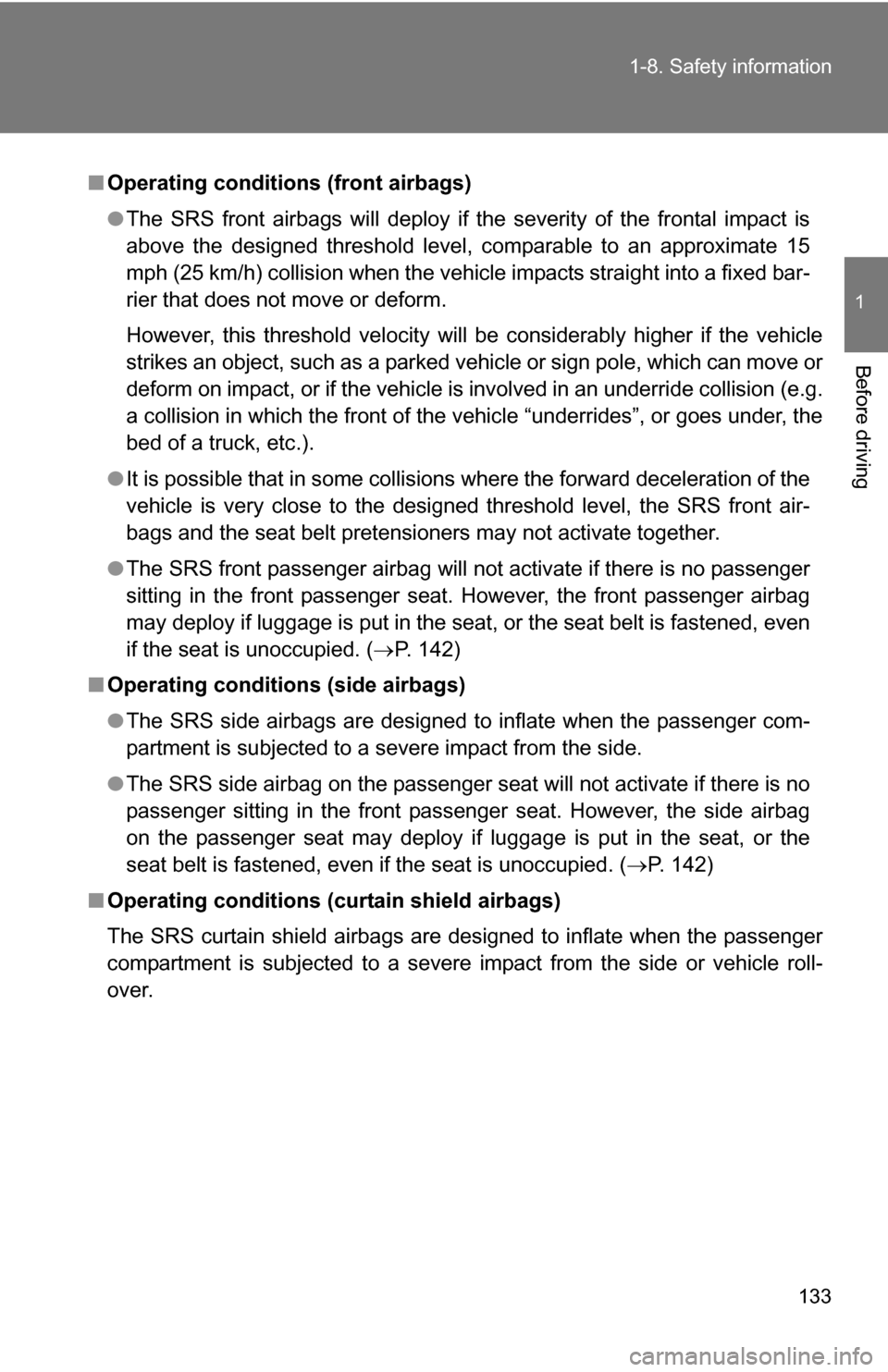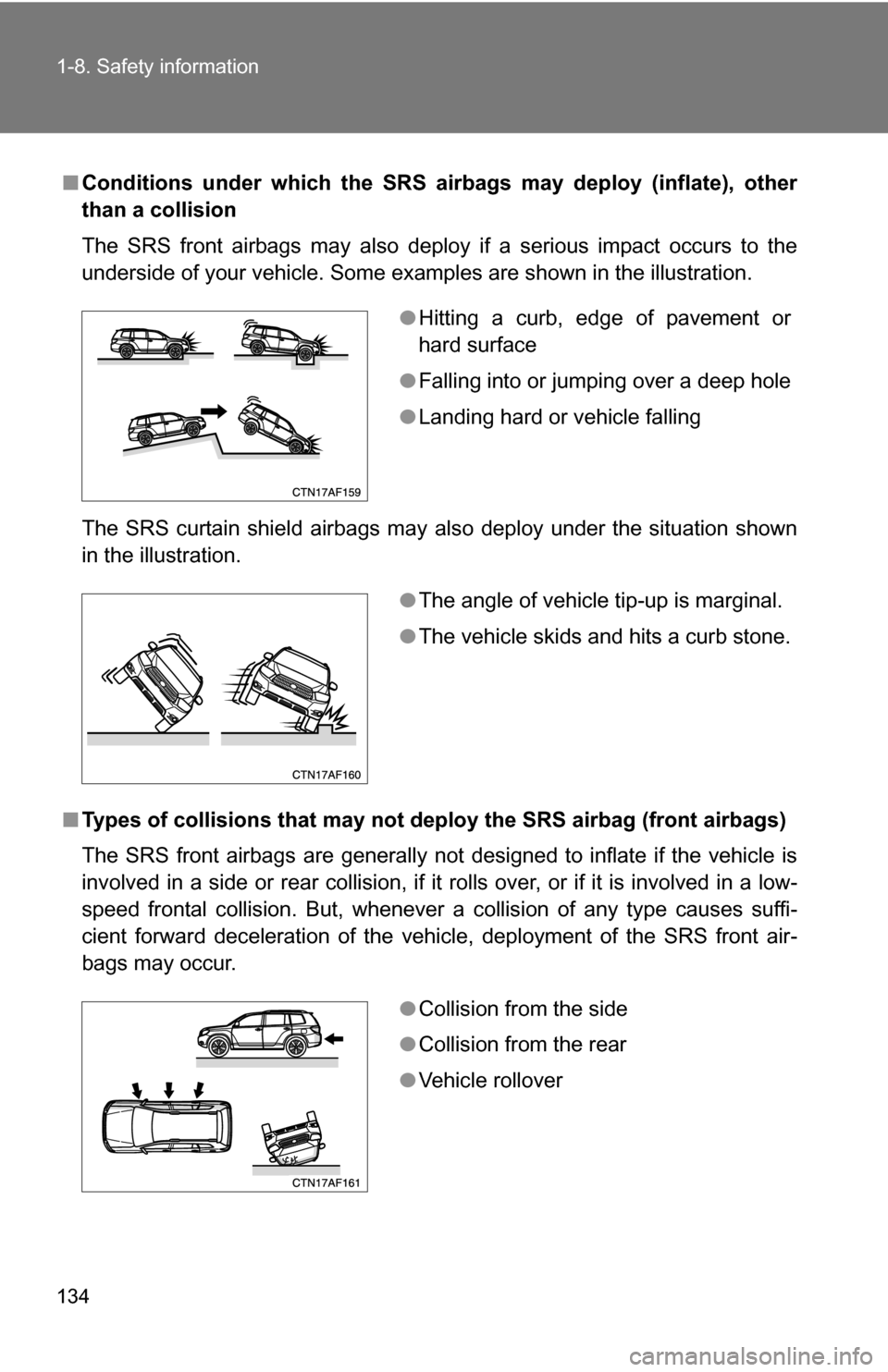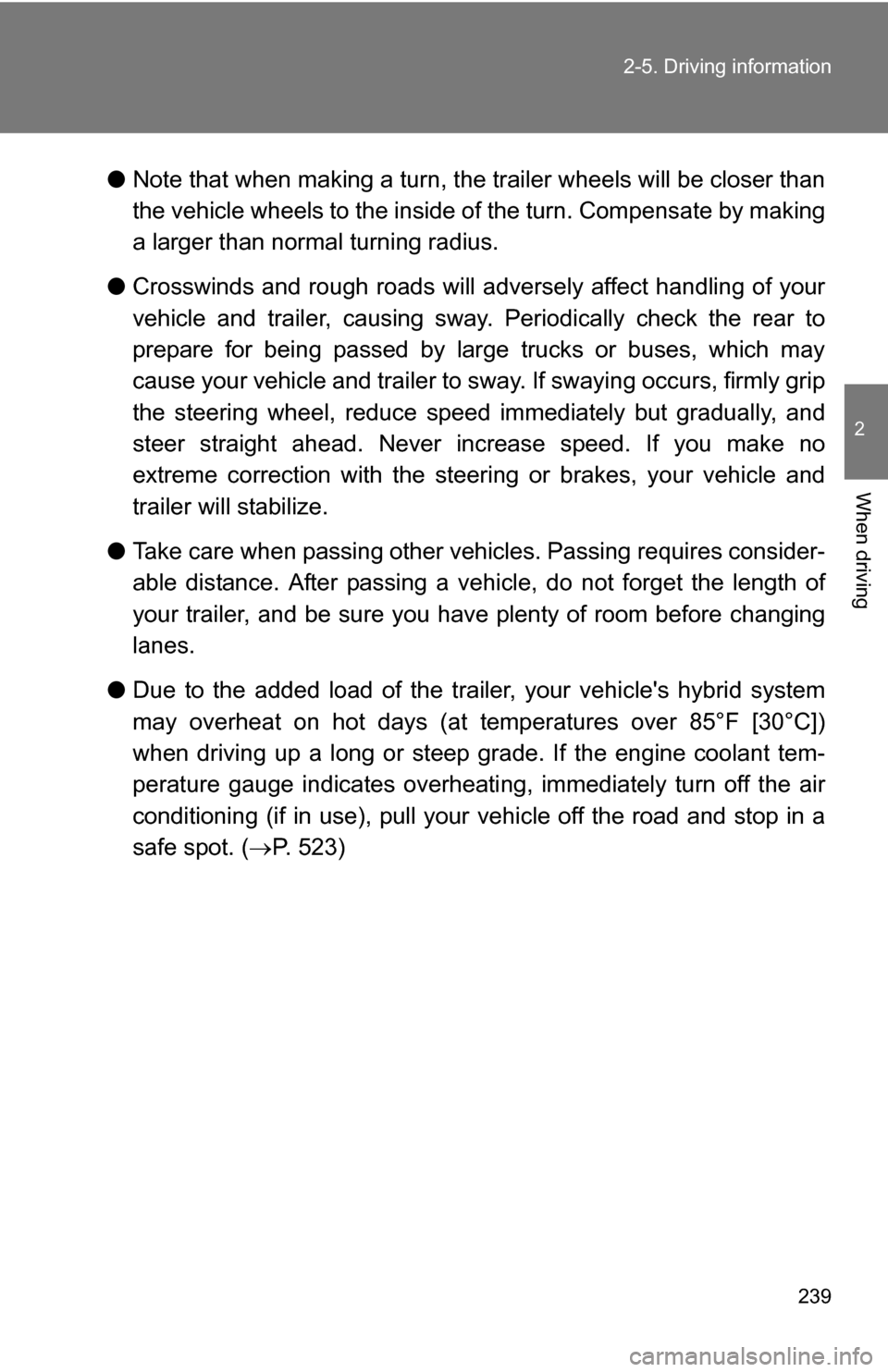Page 133 of 580

133
1-8. Safety information
1
Before driving
■
Operating conditions (front airbags)
●The SRS front airbags will deploy if the severity of the frontal impact is
above the designed threshold level, comparable to an approximate 15
mph (25 km/h) collision when the vehicle impacts straight into a fixed bar-
rier that does not move or deform.
However, this threshold velocity will be considerably higher if the vehicle
strikes an object, such as a parked vehicle or sign pole, which can move or
deform on impact, or if the vehicle is involved in an underride collision (e.g.
a collision in which the front of the vehicle “underrides”, or goes under, the
bed of a truck, etc.).
● It is possible that in some collisions where the forward deceleration of the
vehicle is very close to the designed threshold level, the SRS front air-
bags and the seat belt pretensioners may not activate together.
● The SRS front passenger airbag will not activate if there is no passenger
sitting in the front passenger seat. However, the front passenger airbag
may deploy if luggage is put in the seat, or the seat belt is fastened, even
if the seat is unoccupied. ( P. 142)
■ Operating conditions (side airbags)
●The SRS side airbags are designed to inflate when the passenger com-
partment is subjected to a severe impact from the side.
● The SRS side airbag on the passenger seat will not activate if there is no
passenger sitting in the front passenger seat. However, the side airbag
on the passenger seat may deploy if luggage is put in the seat, or the
seat belt is fastened, even if the seat is unoccupied. ( P. 142)
■ Operating conditions (c urtain shield airbags)
The SRS curtain shield airbags are designed to inflate when the passenger
compartment is subjected to a severe impact from the side or vehicle roll-
over.
Page 134 of 580

134 1-8. Safety information
■Conditions under which the SRS airbags may deploy (inflate), other
than a collision
The SRS front airbags may also deploy if a serious impact occurs to the
underside of your vehicle. Some examples are shown in the illustration.
The SRS curtain shield airbags may also deploy under the situation shown
in the illustration.
■ Types of collisions that may not depl oy the SRS airbag (front airbags)
The SRS front airbags are generally not designed to inflate if the vehicle is
involved in a side or rear collision, if it rolls over, or if it is involved in a low-
speed frontal collision. But, whenever a collision of any type causes suffi-
cient forward deceleration of the vehicle, deployment of the SRS front air-
bags may occur.
● Hitting a curb, edge of pavement or
hard surface
● Falling into or jumping over a deep hole
● Landing hard or vehicle falling
●The angle of vehicle tip-up is marginal.
● The vehicle skids and hits a curb stone.
●Collision from the side
● Collision from the rear
● Vehicle rollover
Page 142 of 580
142
1-8. Safety information
Front passenger occupant classification system
Your vehicle is equipped with a front passenger occupant classifica-
tion system. This system detects the conditions of the front passen-
ger seat and activates or deactivates the devices for front passenger.
Vehicles without navigation system
Vehicles with navigation system
SRS warning light
“AIR BAG OFF” indicator light
“AIR BAG ON” indicator light
Front passenger's seat belt reminder light
Page 143 of 580
143
1-8. Safety information
1
Before driving
Conditions and operation of
the front passenger occupant
classification system
■ Adult*
1
■Child *3 or child restraint system*4
Indicator/
warning light AIR BAG ON and AIR BAG OFF
indicator lights AIR BAG ON
SRS warning light Off
Front passenger's seat belt reminder light
Flashing*2
Devices Front passenger airbag
Activated
Side airbag on the front passenger seat
Curtain shield airbag in the front passenger side
Front passenger's seat belt pretensioner
Indicator/
warning light AIR BAG ON and AIR BAG OFF
indicator lights AIR BAG
OFF*
5
SRS warning light Off
Front passenger's seat belt reminder light Flashing*
2
DevicesFront passenger airbag
Deactivated
Side airbag on the front passenger seat
Curtain shield airbag in the front passenger side Activated
Front passenger's seat belt pretensioner
Page 190 of 580
190
2-2. Instrument cluster
Multi-information display
The multi-information display presents the driver with a variety of
driving-related data, including th e current outside temperature and
clock.
● Outside temperature
Indicates the outside tempera-
ture.
The temperature range that
can be displayed is from -40°F
(-40°C) to 122°F (50°C).
●Clock ( P. 193)
Indicates and sets the time.
● Trip information ( P. 191)
Displays cruising range, fuel
consumption and other cruis-
ing-related information.
● Automatic air conditioning
system display (if equipped)
( P. 253)
Automatically displayed when
the automatic air conditioning
is turned on.
● Rear view monitor
( P. 2 1 1 )
Automatically displayed when
the shift lever is moved into the
R position.
● Warning messages
( P. 500)
Automatically displayed when
a malfunction occurs in one of
the vehicle’s systems.
Page 230 of 580

230
2-5. Driving information
Winter driving tips
Carry out the necessary preparations and inspections before driving
the vehicle in winter. Always drive the vehicle in a manner appropri-
ate to the prevailing weather conditions.
■ Pre-winter preparations
●Use fluids that are appropriate to the prevailing outside tem-
peratures.
• Engine oil
• Engine/power control unit coolant
• Washer fluid
● Have a service technician inspect the level and specific grav-
ity of battery electrolyte.
● Have the vehicle fitted with four snow tires or purchase a set
of tire chains for the front tires.
Ensure that all tires are the same size and brand, and that chains
match the size of the tires.
■Before driving the vehicle
Observe the following according to the driving conditions.
●Do not try to forcibly open a window or move a wiper that is
frozen. Pour warm water over the frozen area to melt the ice.
Wipe away the water immediately to prevent it from freezing.
● To ensure proper operation of th e climate control system fan,
remove any snow that has accumulated on the air inlet vents
in front of the windshield.
● Remove any ice that has accumu lated on the vehicle chassis.
● Periodically check for and remove any excess ice or snow
that may have accumulated in the wheel well or on the
brakes.
Page 239 of 580

239
2-5. Driving information
2
When driving
●
Note that when making a turn, th e trailer wheels will be closer than
the vehicle wheels to the inside of the turn. Compensate by making
a larger than normal turning radius.
● Crosswinds and rough roads will adversely affect handling of your
vehicle and trailer, causing sway . Periodically check the rear to
prepare for being passed by large trucks or buses, which may
cause your vehicle and trailer to sway. If swaying occurs, firmly grip
the steering wheel, reduce speed immediately but gradually, and
steer straight ahead. Never increase speed. If you make no
extreme correction with the stee ring or brakes, your vehicle and
trailer will stabilize.
● Take care when passing other vehicles. Passing requires consider-
able distance. After passing a vehicle, do not forget the length of
your trailer, and be sure you hav e plenty of room before changing
lanes.
● Due to the added load of the trailer, your vehicle's hybrid system
may overheat on hot days (at temperatures over 85°F [30°C])
when driving up a long or steep grade. If the engine coolant tem-
perature gauge indicates overheati ng, immediately turn off the air
conditioning (if in use), pull your vehicle off the road and stop in a
safe spot. ( P. 523)
Page 246 of 580

246
3-1. Using the air conditioning system
and defogger ................ 248
Front manual air conditioning system ....... 248
Front automatic air conditioning system ....... 253
Rear manual air conditioning system ....... 261
Rear automatic air conditioning system ....... 264
Rear window and outside rear view mirror
defoggers ....................... 267
Windshield wiper de-icer ............................ 269
Using the steering wheel climate remote control
switches ......................... 270
3-2. Using the audio system .......................... 271
Audio system (without navigation system) ......... 271
Using the radio ................. 274
Using the CD player ......... 280
Playing back MP3 and WMA discs ..................... 287 Optimal use of the audio
system ........................... 294
Using the AUX adapter .... 297
Using the steering wheel audio switches ............... 299
3-3. Using the rear audio system .......................... 301
Rear seat entertainment system features ............. 301
Using the DVD player (DVD video) ................... 308
Using the DVD player (video CD)...................... 316
Using the DVD player (audio CD/CD text) ........ 318
Using the DVD player (MP3 discs) .................... 319
Using the video mode ...... 321
Changing the initial setting ............................ 323